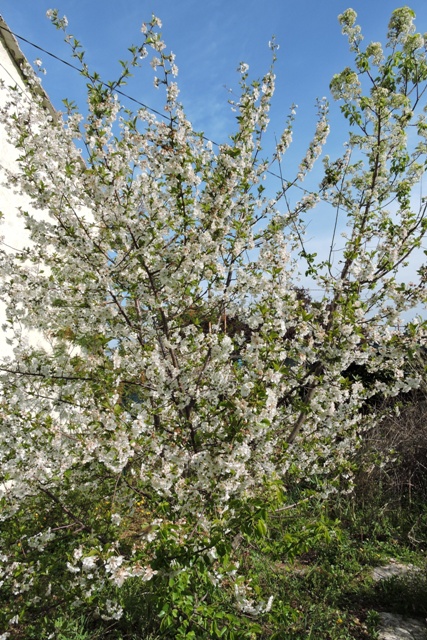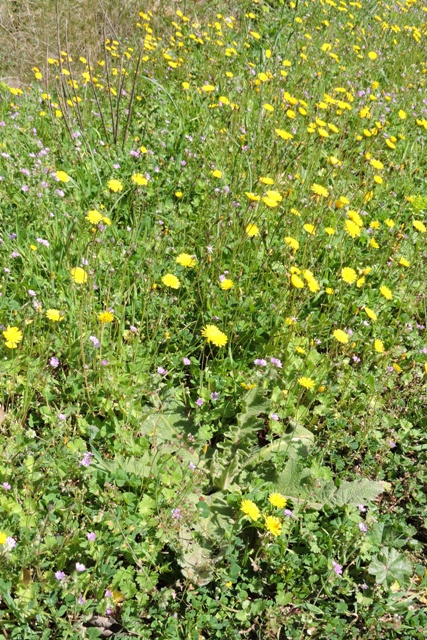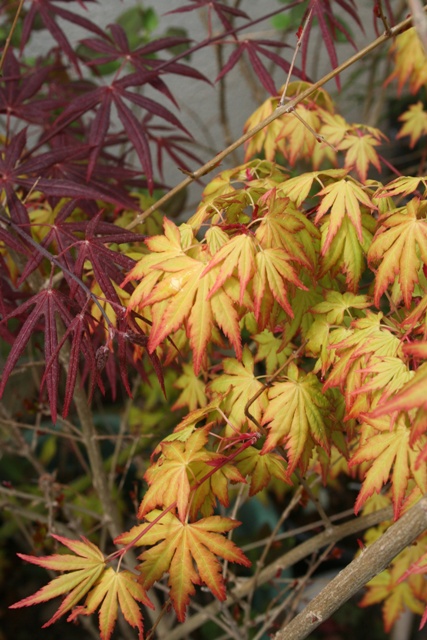In the Konoba
This week: In the Konoba; My next project; Wild flower profusion; A bit of weeping; Looking back;

This week has been another of those “Single issue” weeks, where I have spent the whole week working in and around the big Konoba.
I’m running late with the blog too. My immediate neighbour came round on Saturday afternoon to ask for help with some electrics and in consequence I didn’t get back until almost 6pm.
We have had some cold nights this week. This had been courtesy of the polar air which swept across the UK and northern Europe, as explained in this informative article on the Severe Weather Europe page.
Life giving rain that we had in Dol once again fell as snow on the Dinaric Alps.

In Slovenia, the next country north, albeit 500 km north of Dol, they have recorded an all time record low temperature of -20.6ºC. There was also an unofficial weather station recording of -26.1ºC near Loški Potok.
That is a cold temperature, by anyone’s standards. Here on Thursday morning I recorded a mere +1.1ºC, beating my previous record low of +1.4ºC for this time of year.
The average for nights during the first week of April is +8.7ºC.
I am pleased that I have not removed the shade netting round my citrus trees. Despite the cold, I have a lot of blossom on the cordon apple and pear trees.
Normally I take all the protection netting down on 1st April, but looking at the forecast, I had thought there might be some cold winds, so had left it up.

The sweet Cherry in the Drupe orchard is also absolutely covered in blossom as well. But from my past experience, the fruits when ripe, will provide a feast for the local Blackbirds long before I can pick them.

Once again, after the early warmth in March, this sudden cold is just not normal. The bottom line is that the planet is in a mess with climate change!
In the Konoba
I think the word “Konoba” was the second Croatian word that I learnt.
The first word was “sutra” which just like “Mañana” in Spanish means tomorrow, as in ‘Tomorrow never comes’.
Every traditional home on the island has a “konoba”, but like many things in Croatia, it seems to be a regional term common in the south of Dalmatia, less common in other areas of the country.
The origin of the word is Latin, ‘Canaba’ – a shack or hut.
The first island settlers were the Illyrians, then the Greeks who were followed by the Romans in 219 BC.
With the fall of the Roman Empire in AD 476, Slavic speaking people arrived and there then followed a number of different groups, right up to the Germans in WWII.
All these different cultures have left an imprint on the island, both in physical remains like Greek and Roman watch towers, but also words in the language.
A commonly heard word here is “capisce” [pronounced in English as capish].
It’s Italian and means “do you understand?” in the same way that in both British and American English someone will finish a sentence with “OK?” with the ‘K’ said in a rising tone, or in some parts of England “alright?”. This rising tone and intonation is implying the question “do you understand?”
It’s not surprising that a lot of Italian words are used here, as dialect rather than standard Croatian, because from 1409 until 1797 the island was ruled by the Republic of Venice.
If you look up the word Konoba in a dictionary, it gives the translation of Konoba as “Tavern”.
In the north of the country, Konoba’s are often cellars because the ground is soft and easy to dig. Taverns were also often located in cellars so there is a reason for the standard translation.
Here in the south the land is very rocky. In several places I have the bedrock sticking out of my orchards.
My buildings are built directly onto the bedrock, so 150 years ago, digging a cellar was not an option. Instead the Konobas on the island are on the ground floor of two and three story buildings.
The families living quarters were built above the Konobas, on the first floor and sometimes a second floor too.
So with the exception of the old single story cottage, which is probably my oldest building, all the others have a ground floor Konoba.
Last year when we were remodelling the courtyard, we came across walls suggesting these was a third Konoba which had been demolished.
When I moved in there were two concrete wine vats, taking up 13 cubic metres of space, almost floor to ceiling.

These would hold 10,000 litres of wine. Just imagine 10,000 bottles of wine. That is an awful lot of wine in anyone’s books!
There was also the remains of an olive press, and various other tanks and barrels, all relating to the old use of the building. I needed the space, so I demolished the wine vats, which dated from the 1940’s.

The north wall is more than a metre below soil level, which makes the room damp. The floor is a mixture of modern concrete and eons old stone flags and there are niches all over – just the place for keeping bottles of wine and spirits.

After demolishing the wine vats, I have been using the Konoba as much needed storage space, while building work was taking place. This was especially needed after the container arrived from Abu Dhabi.

There is an interesting article going into much greater details about Taverns, Podrums and Konobas at the Matica website.
My next project
While I wait for the building permission that I need to join the different elements of my home together, I need no permission to carry out inside work.
With the shed now relocated, it’s time to move the last half dozen boxes of the hundreds which came with me from Abu Dhabi. These have been in the Konoba store since the container was emptied.

But first I needed to move the timber that I have kept inside while it seasons.
Along with long lengths, this has also become the depository for offcuts too. Any offcut too large to burn is always saved for future use. It doesn’t look a pretty sight though!

At the start of the week, I began moving the timber onto the racking I built just outside the workshop.
I find that especially with dirty, messy jobs, if I start in one corner and then make steady progress, I am encouraged to continue. Once you see progress being made, it gives one encouragement to continue. If you work hard and see little progress it is demoralising.
I consider this to be my cupboard under the stairs, that glory hole in every home where “things” get put and then forgotten!
By the middle of the week I have made some significant inroads into the mess.

This building has no damp proof course, being built straight onto the sandstone bedrock. The wall facing you in the photograph is about 1.5 meters below the soil level outside and so is quite damp.
To counteract the dampness, I lined the walls with cardboard boxes and plastic sheeting. But nothing is going to waste.
As I have removed the cardboard, I have laid it in the top orchard as a weed suppressant. The plastic is being rolled up and will also get used in other projects.

By the time Friday rolled around, all of the boxes have been moved, flat cardboard has been laid in the orchard and I can now see the walls again. It is a substantial room, with a floor area of just under 40 square metres.

The job of clearing the Konoba was finished today (Saturday). It’s not very often that I start and am able to completely finish a job in a week.

Wild flower profusion
I have had time this week to have a wander along the old donkey track at the back of my home.
This green lane varies greatly by the season, but at the moment there are wild flowers everywhere you look. Here there is a thatch of Crown Daisies, Glebionis coronaria.

A little bit further along and there is a stand of Spanish Broom, Spartium junceum.

Walk a little further and as the soil changes, so do the plants. In this group there are Garden Anemone, Anemone hortensis, and wild Grape Hyacinth, Muscari neglectum.

Whilst we tend to think of flowers being in any number of colours, there are some striking green flowered plants to be seen on the island. At the moment the Common Spurge, Euphorbia helioscopia is in flower.
Each stem is about a metre tall.

As shrubs and small trees die, so they are colonised by lichens. I do not profess to know much about these plants, but this yellow orange lichen may be Xanthoria sp.

But it is not only the plants and flowers that can be seen everywhere. The reptile population has also come out of hibernation.
As you walk, the keen eyes observer will catch a movement and if you are quiet, the lizards will reappear from their hiding places. This Common Wall Lizard, Podarcis muralis, was enjoying the warm spring sunshine.

I enjoy walking through the Maquis because of the huge range of different plants and wild life that I see. I suspect that a lot of visitors – when there are no COVID restrictions that is – completely miss this part of the countryside.
Between the different kinds of pine trees, under foot there is all the evidence you need to tell you what kind of trees they are.
Here the long twin needles and reddish, oval cones identify the trees at Aleppo Pines, Pinus halepensis.

A bit of weeping
I saw that I had a slight weeping from the solar water heater this week, so I was up on the roof to try and see what has gone wrong.
The heating solution is inside high efficiency glass vacuum tubes. These pass through circular rubber seals on the tank, and it looks as though the rubber is starting to perish.
Being well hidden by the vacuum tubes, I think it has been leaking for a while before I noticed the dark drips of solution.

When I say heating solution, is it a a specialist solar liquid, which combines propylene glycol, an antifreeze solution, for frost protection.
But when I read the company website, it says it should be replace every three to five years, depending on condition.
Well the condition does not look good! I collected the drips and the liquid still has the smell and soapy feel of a glycol solution, but I think it has been “cooked”.
That is not surprising here, because in summer the domestic hot water is almost at boiling point. That means that the solution in the tubes must be at or above boiling point.
I already have three quarters of the tubes covered and still have ample hot water. When I checked the level of the glycol solution, although it is a sealed system, it was well down.
But then I have not added any since the system was installed five years ago. This is another of those jobs I didn’t know I had to do. Well I do now!
I need to order another 80 litres (the capacity of the system) of the solution, but as the system is running at the moment, I will wait until the autumn to empty and flush it out.

The job will be a messy one, as each tube has to be individually removed, emptied and then refilled, and all on a cloudy day so there is no solar energy.
I will order the solution, then put it to one side for the next seven months…. There is always a job to do. NCG
Looking back – Week 14
This is the weekly section, with links to past issues of the blog for this week of the year.
2015/14 It’s been a smashing week!

2016/14 How do you start a petrol engine when the cord retract has failed?

2017/14 Wiring with secateurs

2018/14 Sun + warmth + rain = WEEDS

2019/14 Graded grains make finer flowers

2020/14 Cracks are appearing

2 Responses
Andy Robby
Amused to see you’ve got a finger post to Nth Newbald in your konoba. Strangely I have its cousin in my garage pointing to Sproatley!…….
Rick Ellis
Glad to see the “mouse warden” on the job as you cleared out the storage space. Stay healthy and set your own pace. Enjoy following your progress.